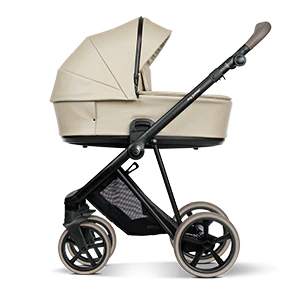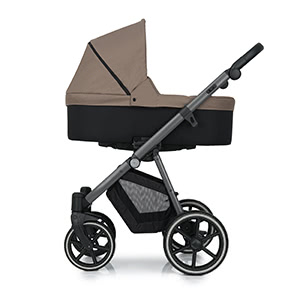
Berechnung des Geburtstermins

Calculate due date.
Congratulations! You’re probably holding a positive pregnancy test in your hand right now and can hardly believe your luck. Pregnancy is an exciting time, full of wonders. One of the first and most thrilling questions is: “When is the big day?” Yes, we’re talking about calculating your due date.
You probably already have a rough idea, but the exact calculated due date is a very special date that you’ll keep in mind throughout your entire pregnancy. However, don’t focus too much on the estimated due date – only about 4% of babies actually arrive on that day.
We’ve put together everything you need to know about calculating your due date and answered the most important questions. From the basics to expert tips – here you’ll find everything you need to know.
Due Date Calculator Basics
Calculating the due date is more than just marking a date on the calendar. It’s the first step in understanding your baby’s development and preparing yourself for their arrival.
Below you’ll find nine of the most frequently asked questions by parents about calculating the due date.
The Top 9 Questions on the Topic: Calculating the Due Date
How is the due date calculated?
Traditionally, the expected due date (EDD) is calculated from the first day of the last period plus 280 days (40 weeks of pregnancy).
This method, known as the Naegele formula or Naegele rule, is based on an average menstrual cycle of 28 days and assumes conception occurs about 14 days after the start of the last period.
Is the due date calculation accurate?
Although this method of calculating the due date is widespread, the actual date of birth cannot be determined with certainty.
In fact, only about 4% of babies are born exactly on their calculated due date. Most births occur within two weeks before or after the estimated due date.
This shows just how individual every pregnancy is and that nature, a woman’s body, and her baby often have their own timetable.
What methods are there to determine the due date?
In addition to the traditional calculation, there are modern methods such as ultrasound scans, which are often more accurate.
Ultrasound can be particularly helpful in early pregnancy for estimating the due date, as it directly visualises the development of the baby.
Other factors, such as the length of the mother’s menstrual cycle and the time of conception, can also be included in the calculation.
How does the mother’s cycle length affect the calculation?
The length of the menstrual cycle plays a significant role. A cycle longer or shorter than the average 28 days can shift the calculated due date.
Adjusting the calculation to the individual cycle can lead to a more accurate result.
What happens if my baby comes earlier or later?
It is completely normal for babies not to be born exactly on the calculated date. Early or late births are common and are professionally overseen by your midwife and gynaecologist.
The most important thing is that mother and baby are well cared for and monitored throughout the pregnancy to ensure both are healthy.
Can I determine the due date more accurately using ultrasound images?
Yes, ultrasound scans, especially in early pregnancy, can offer a more accurate estimate of the due date. They make it possible to observe the development of the embryo or foetus directly and are based on measurable growth standards.
How do irregularities in the cycle affect the calculation?
Irregularities in the menstrual cycle/ cycle length can make calculating the due date more difficult. In such cases, ultrasound scans can be a valuable alternative to determine the length of pregnancy more accurately.
Are there differences in the calculation for first-time mothers compared to those who have given birth before?
The basic method for calculating the due date does not differ for first-time mothers and women who have already experienced several pregnancies.
However, individual factors such as previous pregnancy histories and birth experiences can influence expectations regarding the timing of birth.
How can I prepare for the estimated due date?
Preparing for the estimated due date generally involves organising the place of birth, packing a bag for the hospital, and setting up the baby’s room.
It’s also a good time to learn relaxation techniques and get comfortable with the idea of giving birth.
Have you made a birth plan and considered whether you want to use pain relief (such as an epidural)? Feel free to discuss your wishes with your partner and let them know how you envisage the birth of your child.
Order your free
fabric sample to your home now.
FAQ: Frequently Asked Questions about the Due Date.
What if my baby arrives before or after the estimated due date?
Don’t worry – many babies don’t stick exactly to the calendar.
The most important thing is to keep regular check-ups and appointments with your doctor or midwife and to pay attention to your body’s signals.
Can I influence the due date? The due date can’t be precisely influenced, but there are ways to naturally encourage the onset of labour.
From week 41 of pregnancy, activities such as walking and sex or relaxation techniques like yoga and acupuncture may help. Medical interventions such as induction of labour are only recommended if medically necessary. Ultimately, a natural start to birth is best for both mother and baby.
Due date passed. What now? If your due date has passed, your doctor will monitor the health of both mother and child.
From week 41, various measures can be taken to induce labour. These include rupturing the membranes, prostaglandin gel, or intravenous administration of oxytocin. Medical induction will be carried out if the wellbeing of mother or child requires it.
When and why is labour induced? Labour is usually induced from the 41st week of pregnancy if the baby hasn’t yet been born.
This is done to minimise possible risks for both mother and baby.
If there are signs of poor supply to the baby or other complications, induction may take place earlier. The exact decision always depends on the individual situation of the pregnant person.
Conclusion – Calculating the due date.
The due date of a baby is essential. It’s not just about the day your life changes forever, but also about the deep connection you build with your baby. With the right information and a positive attitude, you can prepare yourself perfectly for this magical moment.
Remember, you’re not alone. Family, friends, and we are here to support you. The journey to motherhood may not always be easy, but it is certainly one of the most rewarding. So, take a deep breath, trust the process and look forward to the miracle that awaits.
Are you ready to determine your baby’s estimated due date? Then simply use our handy online due date calculator.
With your calculator result, and thus your due date in sight, you’ll probably have many more questions about your pregnancy, the individual weeks (gestational age), and birth. In our Pregnancy Guide and my junior® advice section, we are here for you from the very first day and beyond, offering lots of helpful information.
Are you still looking for your dream pushchair?
Here you’ll find our bestsellers

Your world full of advantages.
More protection. More service. More joy.
- 10-year warranty & mobility guarantee
- 1 year comprehensive insurance coverage
- Personalized service
- Mom To Be Academy Online Courses
- Early access at launches
- Upgrades with our hotel partners

 Pushchair
Pushchair  MAVI
MAVI  VIGO²
VIGO²  VITA unique³
VITA unique³  VIGO² Alcantara
VIGO² Alcantara  VIGO
VIGO  VITA HOPE
VITA HOPE  VITA unique²
VITA unique²  PICO³ with tub
PICO³ with tub NOAX²
NOAX²  MIYO²
MIYO²  Pram tests
Pram tests  Consultation
Consultation  Buggies
Buggies  PICO³
PICO³  PLIA²
PLIA²  PLIA² Air
PLIA² Air  PICO³⁶⁰
PICO³⁶⁰  PICO³ with tub
PICO³ with tub  PICO tub
PICO tub  PICO infant car seat adapter
PICO infant car seat adapter  Limited Editions
Limited Editions 











 VIGO
VIGO  VITA HOPE
VITA HOPE  Limited Edition Parasol
Limited Edition Parasol  Limited Edition Baby Carrier
Limited Edition Baby Carrier 
 VITA HOPE
VITA HOPE  Child seats
Child seats  All Isofix Bases
All Isofix Bases  AURAᵉʳᵍᵒ
AURAᵉʳᵍᵒ  Aura Pro
Aura Pro  Beam
Beam  Cyro 360
Cyro 360  Base 360
Base 360  Base Static
Base Static  Capsule System
Bundle
Capsule System
Bundle  Beam Bundle
Beam Bundle  Avionaut Cosmo
Avionaut Cosmo 
 Black Friday Sale
Black Friday Sale
 Reviews
Reviews  Read reviews
Read reviews  Write a review
Write a review 
 Home
Home  Fabric sample
Fabric sample  Baby carriers
Baby carriers  LUVA
LUVA  NAMI
NAMI  NAMI with ring
NAMI with ring  Accessories
Accessories  Vouchers
Vouchers  Discover my junior®
Discover my junior®  About us
About us  In your vicinity
In your vicinity  All my junior
All my junior Flagship Store
Aachen
Flagship Store
Aachen  Flagship Store
Hamburg
Flagship Store
Hamburg  Flagship Store
Salzburg
Flagship Store
Salzburg  Flagship Store Binzen
Flagship Store Binzen
 Flagship Store
Krefeld
Flagship Store
Krefeld  Studio Cologne
Studio Cologne  Studio Trier
Studio Trier  Studio Braunschweig
Studio Braunschweig
 Studio Metzingen
Studio Metzingen
 my junior® pram in
Switzerland
my junior® pram in
Switzerland  Help and Contact
Help and Contact  Useful
Useful  Career
Career  Press
Press 



















